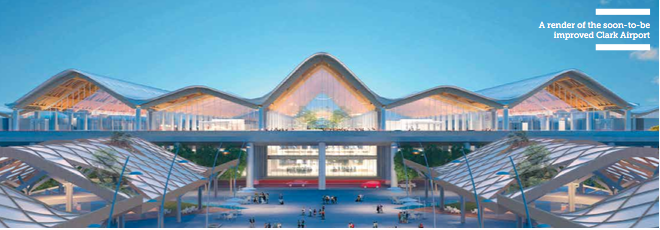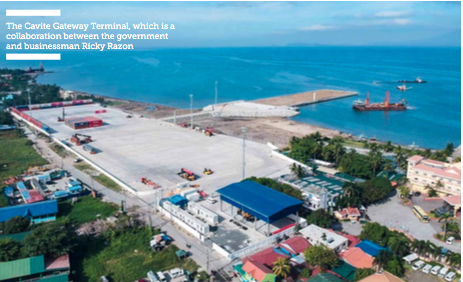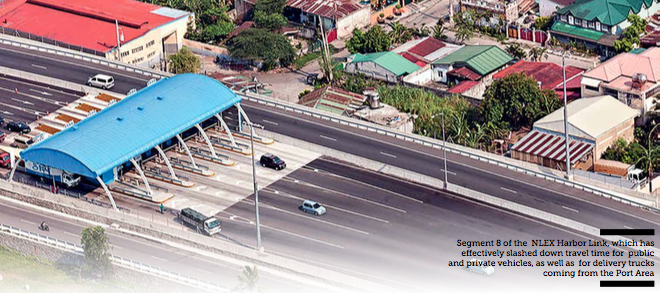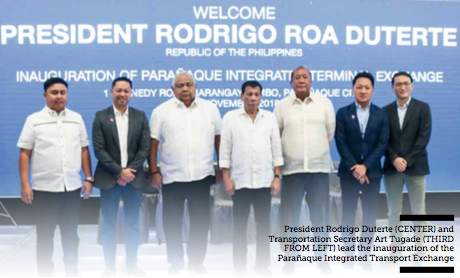Where do our taxes go? It’s a question often asked and almost never convincingly answered, perhaps, until now. These days, if one wonders how the government spends his or her hard-earned taxes, one simply has to look at bridges, land ports, seaports and airports—and in every brick and structure, see the country rise into a glorious future.

By Jose Paolo S. Dela Cruz
As a country of more than 7,000 islands, getting around isn’t exactly the easiest thing to do for the average Filipino. Taking plane rides to the Visayas and Mindanao have become the norm. Being stuck in tra c along EDSA has become a way of life. And while the country has progressed in many aspects in the past, one can also argue that it missed out on one thing: infrastructure.
For over 50 years, the Philippines’ investment in infrastructure averaged only at 2.6 percent of its Gross Domestic Product (GDP), while its ASEAN neighbors invested double that ratio. But that may soon change, as the government, under the leadership of President Rodrigo Duterte, paves the way to a “Golden Age of Infrastructure.”
Recognizing the importance of infrastructure in the country’s development, the President, in his 2017 State of the Nation Address, echoed the people’s sentiments on poor infrastructure systems, speci cally when it comes to road networks and public transportation.

“If we have to embrace the vision of a prosperous Philippines, we have to start putting value to our people’s well-being—because the success of every Filipino’s pursuit to life, liberty and happiness directly mirrors the ful lment of our aspirations as a Filipino,” he said. Along with it, Duterte announced that the government spending on infrastructure will rise from ve percent of GDP in 2017, to seven percent of GDP by 2022, amounting to a total of P 8 to P 9 trillion, or $ 160 to $ 180 billion.
This is where “Build, Build, Build,” steps into the picture. For this ambitious program, the government has set a pipeline of 75 President Rodrigo Duterte (CENTER) and Transportation Secretary Art Tugade (THIRD FROM LEFT) lead the inauguration of the Parañaque Integrated Transport Exchange Flagship infrastructure projects. Of these, 44 are in various stages of implementation as of September. Twenty-three are also in the procurement stage, 11 in the budgeting and financing stage and 10 are already under construction.
Loss and found
Some studies have shown that in Metro Manila alone, at least P 3.5 billion is lost every day due to tra c congestion. Add to that the millions and billions of pesos lost elsewhere and the hefty price tag that comes with these infrastructure projects become more justi able.
And it’s not just about the roads either. “Build, Build, Build,” which is spearheaded by the Department of Public Works and Highways, Department of Transportation, Department of Finance, Department of Budget and Management, e National Economic Development Authority and the Bases Conversion Development Authority, uses a holistic approach that is envisioned to create a ripple e ect in the national economy.
On land, the government has created a Philippine Transport System Master Plan and updated the Transport Roadmap for the Greater Capital Region and High Standard Highway Master Plan. As of June 2018, a total of 1,908 km. of roads have been widened, 328 km. of by-passes and diversion roads were constructed, and 393 km. of missing gaps between national roads have been connected. An impressive 1,316 km. of access roads leading to airports, seaports and declared tourism destinations have also been improved and upgraded.
Among the most recently inaugurated road projects is the NLEX Harbor Link, Segment 10, which will connect MacArthur Highway and C-3. It will decongest Metro Manila’s thoroughfares by providing access to NLEX without passing EDSA or Balintawak. What’s more, the new NLEX Harbor Link will also improve the movement of cargo between NLEX and Radial Road 10, and reduce travel time from Valenzuela to Caloocan City from more than one hour to just ve minutes.
Meanwhile, Laguna Lake Highway has also been opened to the public ahead of time. Aside from possessing its very own bike lane, the P 1.2-billion highway will also reduce travel time from Taytay Rizal, via C5, to Bicutan from an hour to just 30 minutes.
 The NAIA Expressway Phase II, a four-lane elevated expressway from the NAIA Expressway Phase I to PAGCOR Entertainment City, completed in April 2017, now bene ts 80,000 travelers per day by e ectively reducing travel time between Skyway and Terminal 1 from 24 minutes to just eight. It also provides access to all NAIA Terminals from Cavitex.
The NAIA Expressway Phase II, a four-lane elevated expressway from the NAIA Expressway Phase I to PAGCOR Entertainment City, completed in April 2017, now bene ts 80,000 travelers per day by e ectively reducing travel time between Skyway and Terminal 1 from 24 minutes to just eight. It also provides access to all NAIA Terminals from Cavitex.
One of the more ambitious road projects slated for completion is the Luzon Spine Expressway Network, wherein a total of 834.72 km. of roads (more than twice the existing expressways) will reduce the almost seven-hour travel time from Metro Manila to San Fernando La Union, to just three hours.
Projects such as the Parañaque Integrated Terminal Exchange, on the other hand, aim to uplift the travel experiences of the common commuter. e P 3-billion facility is a multi-story, air-conditioned transport terminal that aims to ease the entry of provincial buses from the South to Metro Manila. Similar structures such as the multi-modal transport terminal in Marikina and the Taguig Integrated Terminal Exchange are also being built, as of this writing.
Also on its way are the soon-to-be-constructed Metro Manila Subway, which the government aims to operate by 2022; the additional stations for LRT 2 in Masinag (as seen on the cover), the Mindanao Railway (alongside the Mindanao Road Network improvement); and the installation of bus rapid systems and monorails in key cities like Metro Manila and Metro Cebu, among others.
Connecting a country
The “Golden Age of Infrastructure” also crosses oceans and reaches for the skies.
For starters, the country launched its rst container barge port in November. e Cavite Gateway Terminal will enable efficient  transport of cargo goods from Metro Manila to Cavite, while o ering other port facilities in Luzon via RoRo.
transport of cargo goods from Metro Manila to Cavite, while o ering other port facilities in Luzon via RoRo.
“To improve our sea connectivity, we launched 15 brand new Ro-Ro vessels to ply major nautical routes all over the country. We also opened an ASEAN Ro-Ro Shipping Route connecting the ports of Davao and General Santos, Philippines to Bitung, Indonesia,” said Duterte in his 2017 SONA. Eighteen Ro-Ro ramps have been completed to date.
The government also decongested sea ports by modernizing the Ports of Iloilo, General Santos, Cagayan de Oro and Zamboanga. A total of four passenger terminal buildings and 147 commercial port projects were also constructed, modernized and rehabilitated in the past two years. ese were developed alongside strategic road and bridge projects that will interconnect the country in accordance with the road master plan.
World-class airports have also been constructed for the bene t of local and foreign travelers. e recently inaugurated Panglao-Bohol International Airport, for instance, is touted as the country’s rst resort airport. e new gateway can accommodate as many as two million passengers annually (twice the 800,000 yearly capacity of the Tagbilaran Airport). An architectural wonder, it also uses natural ventilation and harnesses. Panels installed on the roof of the passenger terminal building also produce solar energy that supplies 30 percent of the airport’s electricity requirements.
A modern Philippines
More than the structures though, “Build, Build, Build” becomes an even more worthy enterprise when one sees its importance, not just in growing the economy or modernizing the country, but in improving the lives of Filipinos. As such, measures have also been undertaken to create model communities that Filipinos can live in, once the proper infrastructure has been put into place.
The government, through BCDA and its partner, MTD Capital Behad of Malaysia, is building the rst smart, green, resilient and sustainable metropolis in the country. Phase 1 of the New Clark City involves the construction of the 200-hectare National Government Center (NGAC), which broke ground in January 2018. Of the 200-hectare land, 60 hectares shall comprise the project’s rst phase, with Phase 1A being developed as backup o ces of various agencies to ensure continuous business operations even during times of calamities.
A world-class Sports Complex comprised of an Athletic Stadium and Aquatics Center that can seat 20,000 and 2,000 people respectively, will also be completed in time for the SEA Games in 2019.
“Build, Build, Build” also aims to future-proof the country against calamities by investing significantly in flood control and drainage management plans. Of the 18 major river basins planned, 11, or 61 percent have already been completed.
As the number one consumer of Internet in the world, it’s also no wonder that information and technology are also key concerns for Filipinos. rough “Build, Build, Build,” innovations such as Konek Free Wi-Fi and the National Broadband Plan are also well under way. Once completely rolled out, these projects will give netizens access, not just to Internet, but to fast and reliable connections, as well.
With all these said, it becomes easier to see where our taxes go. For more than the bridges, roads and ports, our taxes are building the future. And what a future it’s shaping up to be!





